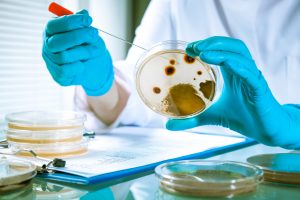They first said germs do not exist.
We’ve been arguing about germs for a long time.
Ignaz Semmelweis (1816-1865), a Hungarian physician, died in an insane asylum in 1865 at the age of 47. He was committed for suggesting that child-bed fever and deaths were caused by germs: germs from the filthy hands of doctors who had dissected cadavers then immediately delivering babies.
The medical and scientific communities were highly offended at Semmelweis’ suggestion that they should wash their hands.
After hand-washing protocols were implemented, the mortality rate dropped from 18.27 per cent, to 1.27 per cent, to zero.
They next said germs do exist.

Not long after, a German and a Frenchman were revered for their “discovery” of germs.
The French wine industry engaged French chemist and microbiologist Louis Pasteur (1822-1895) to identify the process of fermentation. It was all about the wine. He developed ways to prevent wine from being contaminated by unwanted microorganisms. Thus, “pasteurization” was born.
Robert Koch (1843-1910), a German microbiologist, took it a step further by identifying the relationship between specific germs and diseases. He devised a method for testing which germ caused which disease, and Koch’s Postulates resulted. These four postulates are worth examining, as they inform the battle-ready stance against bugs that prevails to this day.
Koch nabbed the bacteria responsible for dreaded tuberculosis, winning him the Nobel prize for advancing this newfound knowledge that germs caused disease.
With germs as culprits, we began to inoculate.
Prior to Pasteur and Koch conducting their research, the English physician Edward Jenner (1749-1823) was experimenting with cows. He observed that milkmaids who contracted cowpox, a relatively mild disease, were immune to deadly smallpox. One such milkmaid caught cowpox from Blossom, her dairy cow. Jenner took pus from the milkmaid’s sores and rubbed it onto a scratch on a subject’s arm. His subject, James Phipps, did indeed come down with a mild case of cowpox, and this is where it gets interesting.
Jenner then intentionally infected James with smallpox. The boy’s enhanced immunity was able to resist the smallpox virus and he didn’t get sick. Presto–inoculations were invented.
The risk with using foreign media is the inevitability of also acquiring unknown viruses common to species other than humans. We have seen repercussions of this with polio inoculations containing Simian Virus 40.
Germs can now be manipulated.
At the same time, a medical doctor from Vienna, James Compton Burnett (1840-1901), expressed concern over the new practice of innoculation. Steeped in homeopathic theory, Burnett postulated that grafting a foreign disease onto the body would have far-reaching negative effects.
Inoculation exemplifies an attempt to exercise domination over all pathogens, and insulate the human biome from perceived pathogenic effects.
The human vital force evolved to acquire infectious contagious disease naturally. The innate wisdom of the vital force governs the physical body, the energy body, and the spiritual body. It has been doing an eloquent dance with the process of maturing the immune system since time began. The principle of vitalism governs this concept.
Vaccinosis is the grafting of a foreign disease onto the human being by bypassing the normal mechanism of contracting disease, which takes place through mucosal membrane. Injecting pathogens directly into the bloodstream is an unnatural introduction.
Have you noticed the increase in exaggerated forms of inflammation such as eczema, asthma, mollescum, and serious autoimmune irregularities? This is because when you impose an immune challenge containing excipients and foreign mediums, bypassing the innate arm of the immune system, the humoral arm overreacts, producing a terrifying array of compensatory responses. The individual now has unfamiliar disease grafted upon the human biome.
For more information on vitalism and factors that detrimentally effect our immune system, check out Cilla’s class on the Health Helix.
Manipulating germs carries terrifying risks.
This manipulation derails the brilliant design of Mother Nature and her natural evolution of immunity that’s taken place over millions of years. Burnett posited that homeoprophylaxis would be much safer and support the natural immune process. Homeoprophylaxis aims to integrate and synchronize the human species with other life forms, in the most compatible way, instead of imposing separation.
In the late 1700s Samuel Hahnemann (1755-1843), physician, chemist, and linguist, discovered that his patient taking homeopathic belladonna was immune to the scarlet fever epidemic to which all her family members had succumbed. With this, the first homeoprophylaxis application was discovered. It continued to work prophylactically for others and the King of Prussia mandated its use to stem future scarlet fever outbreaks.
Homeoprophylaxis collaborates with germs.
Since there is no material substance in a homeopathic remedy, it does not act in a physiological manner. Rather, it is energetic, meaning the solution contains the frequency of the source material after being diluted repeatedly until no molecules remain. And why is this important?
Manipulation carries risk, then let’s not manipulate! Mother Nature knows what she’s doing. The evolution of these microbes—bacteria and viruses–has occurred right alongside of humans. All life forms have a place and are interrelated. We will never understand the full implications of manipulating them to what we assume is our benefit.
Homeoprophylaxis honors our relationship with other organisms. Instead of manipulation, it offers cooperation. By introducing the frequency of a pathogen to the human organism, a recognition takes place. It’s like downloading information.
According to Carlo Rubbia, Italian physicist and Nobel Laureate (1984) in physics, “Less than one billionth of the universe is matter – the rest is energy and information.”
Recognition of this information provides a reference point. When the pathogen is met in nature, its frequency is recognized. Either the human doesn’t contract the disease, or a natural and appropriate immune response takes place. As studies have shown no antibody production with homeoprophylaxis, there is no artificial emphasis on the humoral arm of the immune system.
Natural immunity is the goal.
Gustavo Bracho, PhD, is an immunologist with the Findlay Institute in Havana Cuba. In 2010 he injected rats with leptospirosis after orally receiving homeoprophylaxis. Eighty percent did not contract the disease while producing no antibodies. The rat control group without homeoprophylaxis all died. Bracho and others have suggested that becoming familiar with the frequency of a disease confers all the benefits of receiving the wild disease, without the risks. Because there is nothing material in the exchange, there is no resulting chaos from manipulation through attenuation, additives, or introduction in a way other than nature’s way by contraction through mucous membrane.
Homeoprophylaxis does not manipulate.
We have a clear example of wreaking havoc by suppressing bacteria when antibiotics were the magical discovery of 1928 and in full scale use by the 1940s. Sure, they gave a one-two punch to the scourge of syphilis, but at what cost? It became too easy to simply prescribe antibiotics for every perceived infection. When you reduce one population, another expands to take its place, and here we go again. Manipulation!
This has not been the case with over 200 years of clinical observation of homeoprophylaxis. In fact, based on Isaac Golden’s 15-year study with 3000 children, more robust long-term health was observed in the HP group than in unvaccinated children. Surprisingly, they experienced fewer ear infections, allergies, and eczema.
To ensure health, we must co-exist.

By introducing pathogens in their energetic state, one disease at a time, there is no disruption of the natural relationship we humans share with these microbes.
We do not have all the answers. We never will. In the end, we benefit from the presence of these other life forms to communicate information, to digest our food, maintain homeostasis, and even shape emotional temperament.
They are in, on, and around us all the time, contributing to our immune maturation and evolution. In fact, the human organism is made up of only 10% human cells; the rest is bacteria, viruses, fungi, and parasites.
Additionally, according to the endosymbiotic hypothesis, cellular mitochondria closely resemble certain bacteria and this symbiotic relationship was probably formed millions of year ago in the process of evolution.
Our relationship with all other life forms is meant to reflect respect and mutual cooperation in order to assure the balance of life itself. Relating with pathogens as information is more beneficial, less invasive, and enables peaceful co-existence.
The war against disease ends.
To learn more about real immunity
Watch my three-part docu-series Real Immunity.”
Get Healing Our Relationships with Microbes for $3.99
